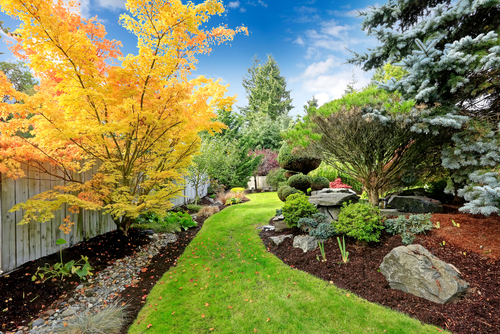How Landscape Design Trends Have Evolved Over the Years
When choosing the style of your new home project, whether it be landscaping, kitchen countertops, new floors, or a change of paint, one key factor comes to mind: current trends.
Homeowners constantly seek to achieve what’s “in,” but like many fashion trends, they’re often fleeting. What’s “in” one year may be “out” the next.
Over the years, landscape design trends have evolved, recycled, and some have even remained. Looking back at the history of landscape designs can help you get an idea of what you like, and even help you predict what’s coming next.
At Darlington Designs, we make it our point to stay current (and even ahead) of the trends and provide our clients with exceptional designs. We take our carefully curated designs and seamlessly translate them during the building process, ensuring our clients are delivered a final product that is sure to exceed their expectations. With expertise in outdoor living, construction, and pools and spas, we provide a one-stop-shop for clients looking to achieve the landscape of their dreams.
Which Landscape Features Have Withstood the Test of Time?
Below, we’ve broken down the most popular landscape trends throughout the decades. Take notice of the ones that were a flash in the pan, opposed to those that withstood the test of time, and repeated.
50s
The 1950s were influenced by the idea of consumerism. Thus, a lot of homeowners’ style choices reflected this. Landscapes had garden gnomes, plastic pink flamingos, oversized, vibrant-colored flowers, and round/box-pruned shrubbery. Landscaping was considered a “first important look” into a family’s wealth and status. This often meant landscapes needed to be perfectly manicured and brightly colored.
The backyard evolved from a utilitarian space to a social space in the 50s. Patios, porches, outdoor dining areas, and barbeques replaced the clotheslines and trash bags that used to fill backyards. Pools and spas started to grow in popularity, contributing to the evolution of backyards.
60s
 The 1960s represented a time where there was a strong focus on family and living the “suburban dream.” With that, popularity in backyard use continued to grow from the 1950s. Get-togethers, picnics, parties, games, and barbeques were all favorite pastimes.
The 1960s represented a time where there was a strong focus on family and living the “suburban dream.” With that, popularity in backyard use continued to grow from the 1950s. Get-togethers, picnics, parties, games, and barbeques were all favorite pastimes.
Consumerism also continued to reign throughout the 60s, with landscapes serving as status markers and symbols of wealth, holding strong from the previous decade. With irrigation advances, the ability to have a well-groomed lawn became possible for a wider base of consumers, leading to a decade-wide obsession with having a vibrant-green lawn.
70s
The 1970s designated a shift from consumerism to natural design. After the heavy emphasis of showmanship from the past two decades, consumers longed to get back to natural roots and “the way things were.” This caused a spiked interest in growing gardens, and using gardens as a form of landscape decoration.
80s
The 1980s’ landscape design trends were largely influenced by the emergence of computer technology. Landscape designers and architects became able to complement hand-drawings with computer-based designs.
This advancement in technology led to a demand for complex, elaborate landscape designs. Gardens continued to grow in popularity, and were widely considered “extensions of the home.” Outdoor living spaces also came back in style, showing a resurgence in backyard gatherings and a place for spending quality time.
90s
The 1990s were shaped by the emergence of DIY projects, as well as home makeover and garden design TV shows. These trends all propelled an interest in beautifying homeowners’ outdoor space.
Urban populations grew at the fastest rate in history during this time. These demographics were looking into traditional landscaping alternatives, such as small-space gardening, trellises, and permanent planters.
2000s-2010s
Consumers started to trend towards healthy living again, which prompted edible landscaping to come back in style. There was also a focus on “going green.” Consumers began choosing vegetation that was native to the areas they lived in, and ensured that style choices did not post a threat to the environment.
Composting and xeriscaping (reducing/eliminating the need for supplemental water from irrigation) also grew wildly popular, and continues to grow in popularity to this day.
2020s
Today, consumers continue to value sustainability, with low-maintenance gardens, drought-tolerant plants, and edible gardens all trending. Homeowners prefer higher-quality, natural materials that blend with the environment, rather than showy styles from the past.
Self-contained water features are becoming popular complementary elements to incorporate into landscapes.
Comprehensive, permanent outdoor living spaces and structures are also growing in popularity, with the advancements in weatherproofing and structure resiliency.
What’s Next for Landscape Design Trends?
Only time will tell.
Trends come and go, but one thing remains: Darlington Designs’ commitment to being at the forefront of the landscape design and build trends.
Contact us today at info@darlington-designs.com or call us at 856-442-0440. We proudly serve local neighborhoods in Southern New Jersey and the Greater Philadelphia region.
Also, feel free to contact us via our project form found at the bottom of our Outdoor Living page.



